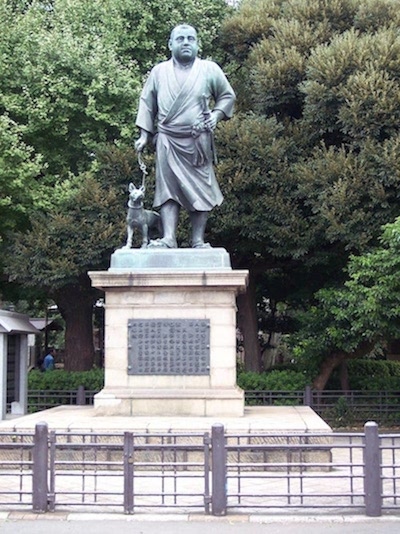Saigo Takamori, the most powerful driving force behind the Meiji Restoration, died in disgrace ten years later as the leader of the Satsuma Rebellion of 1877. Saigo was a close friend of Katsu Kaishu, “the shogun’s last samurai” of my Samurai Revolution. Kaishu remained loyal to his friend even during the years of Saigo’s posthumous ignominy. I wrote extensively about Saigo, including his relationship with Kaishu, in Samurai Revolution.
One of my favorite places in Tokyo during the many years I lived there was Ueno Park, a treasure trove of history and culture. And one of my favorite spots in the park is the statue of Saigo.

Following is an excerpt from my Samurai Tales regarding the statue (footnotes excluded):
* * *
On February 11, 1889, the Meiji Constitution was promulgated, marking the beginning of representative government in Japan. On the same day, Saigo was exonerated and redecorated with the senior third rank for his achievements during the Restoration years. Two years later it was decided that a great statue would be erected to his memory at Ueno Park in downtown Tokyo. “So what if they’ve erected a statue to Saigo!” Katsu said just days before the unveiling ceremony on December 18, 1898, a month before his death. “Is the statue going to say ‘thank you very much’ [to Saigo]?” he asked. “That’s strange! Statues don’t talk.” Having thus vented his disgust for the past harsh treatment of his friend, he added, probably tongue in cheek (but certainly not without an element of sincerity), “Saigo was only Saigo because of me.” When invited to give a speech at the unveiling ceremony, Katsu, who was ailing, at first refused because it was “ridiculous,” and anyway “I don’t know how to give a speech. . . . [Besides], it’s too cold for me to be dragged out to Ueno. And everyone there will be putting on airs as if they’re so very important.” The event organizers would not accept Katsu’s refusal, and he eventually agreed to attend the unveiling. Katsu recited several short poems that he had written in Saigo’s memory. Regarding the famed statue: “It’s poorly made,” he said.
The weathered bronze statue, always covered with pigeon droppings, is situated on a height overlooking the bustling streets and train station of Ueno. It is a symbol of the Japanese capital and favorite photo spot among tourists from the provinces. Over the past century it has become part of the landscape of the park, like any of the venerable old cherry trees that line the walkways of the spacious precincts and under whose gossamer blossoms people have been celebrating the arrival of spring since the days of the Tokugawa Bakufu. I have visited the statue more times than I remember, and each time I pause before the monument—out of sheer admiration for the great warrior and humanist.
Saigo’s statue, set atop a high pedestal, lacks the pomp and glory of statues erected for military heroes in countries throughout the world. Saigo is neither mounted atop a war steed, nor attired in military dress, nor decorated with medals, nor armed with anything but a simple short sword. His head is bare, his hair cropped; he is dressed plainly in a loose-fitting, short-sleeved kimono and straw sandals. With his left hand he grasps his sword, stuck through his sash at his left hip. His dog is with him, whose leash he holds in his right hand, as if out hunting rabbit in the rugged mountains of his beloved Satsuma. The large round eyes are penetrating; the heavy, firm jaw resolute; the limbs and body stout and stalwart—and this statue of the humanist whose cherished slogan was “Revere Heaven, love mankind,” of the warrior whose spiritual and physical magnanimity earned him the epithet “Saigo the Great” and the adoration of an entire nation, of the stoic who considered love of oneself a crime, is truly a monument for the people.
Saigo’s widow, Itoko, agreed with Katsu’s assessment of the statue. Itoko traveled from distant Kagoshima to attend the unveiling ceremony with other members of the Saigo family. She sat next to her late husband’s younger brother, the Marquis Saigo Tsugumichi, who had occupied high posts in the Meiji government, including minister of the navy and minister of the interior. The illustrious gathering waited silently for the veil to be removed. When the statue was finally uncovered, revealing the image, Itoko emitted a sudden shriek. “It looks nothing like my husband,” she exclaimed. She was immediately silenced and later reprimanded by Tsugumichi, out of regard for the “feelings of those many people who went to such trouble and expense to produce the statue.” But Itoko would never overcome her embarrassment at the statue’s informal attire “for all the world to see”—because in life Saigo “was a man of the utmost decorum” who would have worn the formal “hakama and haori bearing the family crest, or a military uniform.”
* * *
The paperback edition of Samurai Tales was published by Tuttle in August 2015.
(Portrait of Saigo from Kagoshima Prefectural Museum of Culture Reimeikan)
For updates about new content, connect with me on Facebook.
